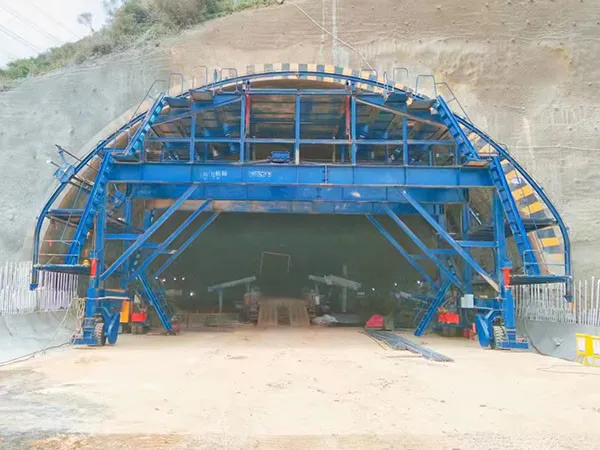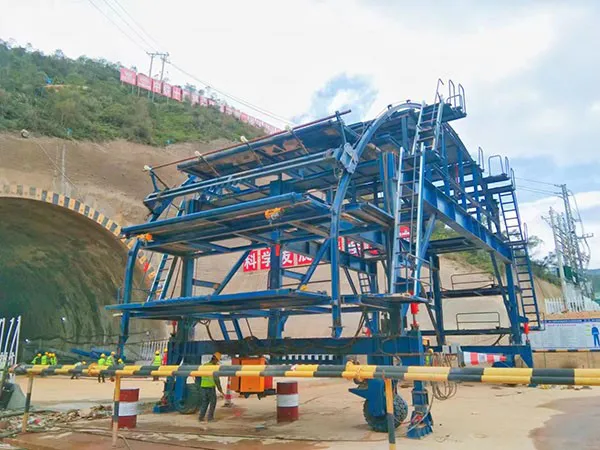Subway tunnel lining trolleys are essential non-standard equipment used in the secondary lining process of tunnel construction, especially for urban metro systems. Unlike the generic "tunnel lining trolley" which encompasses various applications (highway, railway, hydropower, etc.), subway tunnel lining trolleys are specifically designed to meet the unique requirements of metro tunnel sections and stations.
While there isn't a universally standardized set of "models" like you'd find for a mass-produced consumer product, these trolleys are typically categorized and described based on several key characteristics and design principles:

Section Trolley : This is the most common type, designed for the long, continuous tunnel sections between subway stations. Their design focuses on efficient, repeatable lining for a consistent circular or horseshoe-shaped cross-section.
Station Trolley: These are specialized for the larger, often more complex and varied cross-sections of subway station caverns. They might be designed to handle rectangular, multi-arch, or other irregular shapes.
Button-Arch Trolley: Used for specific sections like the "button-arch" (inverted arch or invert) at the bottom of the tunnel, especially for the secondary lining of the invert.
Middle Partition Trolley : For tunnels with a central partition wall, these trolleys are designed to facilitate lining in these specific configurations.
Hydraulic Automatic Walking Lining Trolley: This is the most prevalent and advanced type. They utilize hydraulic systems for movement, formwork adjustment (expanding, retracting, lifting, lowering), and often for precise positioning. They are self-propelled, driven by electric motors.
Mechanical Lining Trolley: While less common now for large-scale projects, older or simpler designs might use mechanical systems for movement and formwork manipulation.
Hydraulic Drag Type: These trolleys are dragged by external equipment, but still use hydraulics for formwork operations.
Side Arch Type: Common for tunnels with a side wall and arched roof.
Round Needle Beam Type: Used for tunnels with a full circular cross-section, where the "needle beam" supports the formwork. Often applied in water diversion or conveyance tunnels, but concepts can apply to circular subway tunnels.
Bottom Mold Needle Beam Type: A variation of the needle beam type, specifically incorporating a bottom mold.
Round Through Type: For a continuous circular lining.
Segmental Arch/Horseshoe Trolleys: Designed for specific, non-circular tunnel shapes.
Telescopic Trolleys: These have sections that can extend or retract to accommodate slight variations in tunnel diameter or to facilitate easier movement.
Integral/Overall Lining Trolley: Designed to line the entire tunnel section in one pour.
Sectional/Modular Lining Trolley: Composed of multiple modules that can be assembled and adjusted, offering flexibility for different tunnel cross-sections or for transport.

Tunnel lining trolleys, including those for subways, are available in various standard lengths for each pour, typically ranging from:
4.5 meters
6 meters
7.5 meters
9 meters
10.5 meters
12 meters
15 meters The choice of length depends on the tunnel's total length, construction schedule, and site-specific conditions.

High Precision: Subway tunnels require high precision in lining to ensure smooth operation of trains and structural integrity.
Adaptability: Often designed to be adaptable to slight variations in tunnel cross-section, especially for shield-driven tunnels.
Automation: Modern subway trolleys are increasingly automated, incorporating sensors and control systems for precise positioning, concrete pouring, and demoulding.
Safety: Emphasize safety features due to the confined space and often complex operations.
Efficiency: Designed for rapid setup, pouring, and demoulding to meet tight construction schedules.
Customization: Due to the unique nature of each subway project, trolleys are often custom-designed or highly customized based on the tunnel's specific dimensions, shape, and construction methodology.
Instead of fixed "models," manufacturers of subway tunnel lining trolleys typically offer a range of customizable solutions based on the above classifications and the specific project's engineering requirements.
Gaofei
Address: 200m east of tulip garden, group 12 of zhangling community, hongshan street office, hongshan town, xigong district, Luoyang
Tel: +8616638856888
Contact: Gaofei Huang
Mobile: +86-18637923976
Phone: 0379-80881719/ 0379-60162687
QQ: 286827457
E-mail: gaofei@gf-bridge-tunnel.com